
Vaccinium vitis-idaea is a short evergreen shrub in the heath family that bears edible fruit, native to boreal forest and Arctic tundra throughout the Northern Hemisphere from Eurasia to North America. Lingonberries are picked in the wild and used to accompany a variety of dishes in Northern Baltoscandia, Russia, Canada and Alaska. Commercial cultivation is undertaken in the U.S. Pacific Northwest and in many other regions of the world.

The geometer moths are moths belonging to the family Geometridae of the insect order Lepidoptera, the moths and butterflies. Their scientific name derives from the Ancient Greek geo γη or γαια "the earth" and metron μέτρων "measure" in reference to the way their larvae, or inchworms, appear to "measure the earth" as they move along in a looping fashion. A very large family, it has around 23,000 species of moths described, and over 1400 species from six subfamilies indigenous to North America alone. A well-known member is the peppered moth, Biston betularia, which has been subject of numerous studies in population genetics. Several other geometer moths are notorious pests.
In Greek mythology, two sacred mountains are called Mount Ida, the "Mountain of the Goddess": Mount Ida in Crete; and Mount Ida in the ancient Troad region of western Anatolia which was also known as the Phrygian Ida in classical antiquity and is the mountain that is mentioned in the Iliad of Homer and the Aeneid of Virgil. Both are associated with the mother goddess in the deepest layers of pre-Greek myth, in that Mount Ida in Anatolia was sacred to Cybele, who is sometimes called Mater Idaea, while Rhea, often identified with Cybele, put the infant Zeus to nurse with Amaltheia at Mount Ida in Crete. Thereafter, his birthplace was sacred to Zeus, the king and father of Greek gods and goddesses.
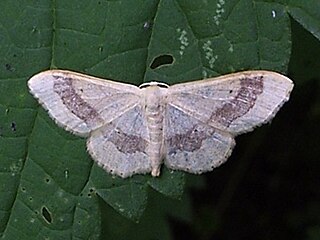
The riband wave is a moth of the family Geometridae. The species was first described by Carl Linnaeus in his 1758 10th edition of Systema Naturae.

Idaea, sometimes called Hyriogona, is a large genus of geometer moths. It was erected by Georg Friedrich Treitschke in 1825. They are found nearly worldwide, with many native to the Mediterranean, the African savannas, and the deserts of western Asia.

Idaea degeneraria, the Portland ribbon wave, is a moth of the family Geometridae. The species was first described by Jacob Hübner in 1799.

Idaea flaveolaria is a moth of the family Geometridae first described by Jacob Hübner in 1809.
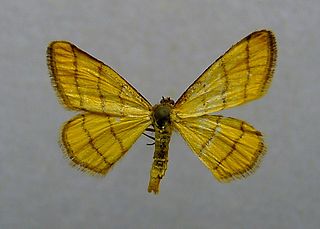
Idaea aureolaria is a species of moth of the family Geometridae. It is found from Spain and France through central Europe to the Balkan Peninsula and east to Siberia. It is also found from Turkey to Central Asia.

Idaea furciferata, the notch-winged wave moth, is a moth in the family Geometridae. It is found in North America, where it has been recorded from Maryland to northern Florida, west to Missouri and Texas.
Idaea or Idaia is the name of several figures in Greek mythology, it means "she who comes from Ida" or "she who lives on Ida", and is often associated with Mount Ida in Crete, and Mount Ida in the Troad.
Idaea retractaria is a species of geometrid moth in the family Geometridae. It was described by Francis Walker in 1861 and is found in North America.
Idaea basinta, the red-and-white wave, is a species of geometrid moth in the family Geometridae. It was described by William Schaus in 1901 and is found in Central and North America.
Idaea productata is a species of geometrid moth in the family Geometridae. It was described by Alpheus Spring Packard in 1876 and is found in North America.
Idaea microphysa is a species of geometrid moth in the family Geometridae. It is found in North America.
Idaea eremiata, the straw wave moth, is a species of geometrid moth in the family Geometridae. It is found in North America.
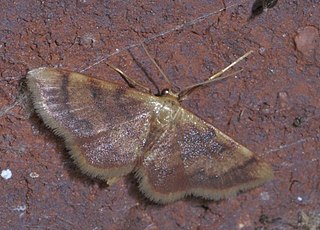
Idaea demissaria, the red-bordered wave moth, is a species of geometrid moth in the family Geometridae. It is found in North America.
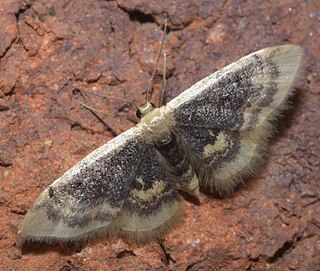
Idaea scintillularia, the diminutive wave, is a species of geometrid moth in the family Geometridae. It is found in North America.
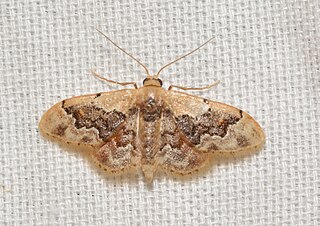
Idaea gemmata is a species of geometrid moth in the family Geometridae. It is found in North America.

Idaea celtima is a species of geometrid moth in the family Geometridae. It is found in North America.
In Greek mythology, Idaea or Idaia was, by some accounts, the daughter of the Scythian king Dardanus, and the second wife of Phineus, the king of Thrace. Idaea's false accusations against her stepsons, were responsible for her husbands misfortunes. She was sent back to Scythia, where she was condemned to death. Other ancient sources give other names for Phineus's second wife, including: Eidothea, sister of Cadmus, and Eurytia.













